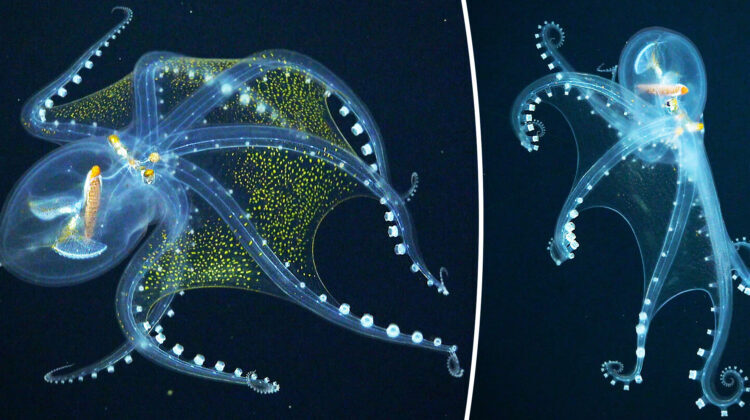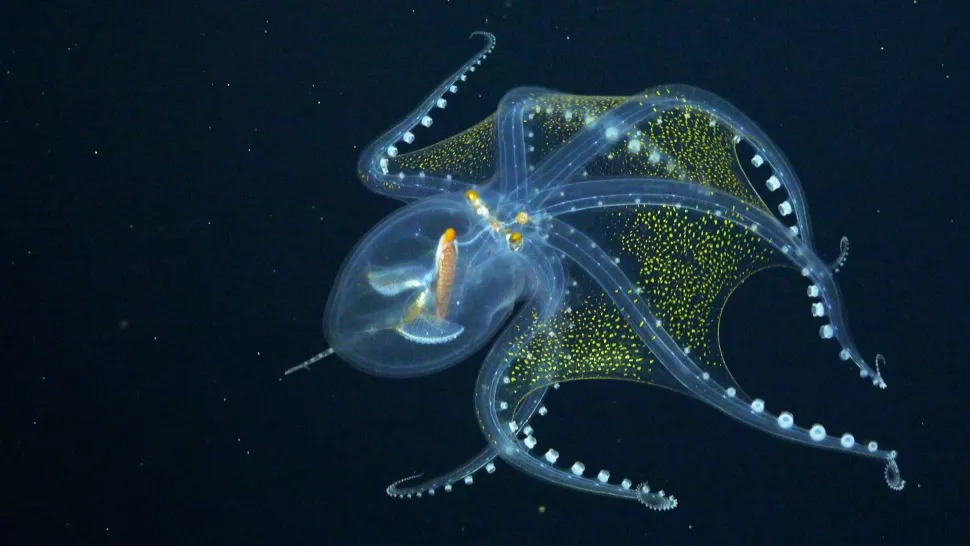
When an underwater robot videotaped this seldom observed glass octopus gracefully flying through the deep waters of the Central Pacific Ocean, it revealed everything, even a peek of its innards.
During a 34-day expedition off the isolated Phoenix Islands, an island located more than 3,200 miles (5,100 kilometers) northeast of Sydney, Australia, marine biologists discovered the elusive glass octopus (Vitreledonella richardi).
Glass octopuses, like glass frogs and certain comb jellies, are almost totally transparent, with just their cylindrical eyes, optic nerve, and digestive tract looking opaque. The expedition crew reported two encounters with the glass octopus, which is an astonishing number given that scientists previously had to learn about them by studying fragments of them in the digestive contents of their predators.

It wasn’t until 1918 that glass octopuses were discovered. According to the International Union for Conservation of Nature, these cephalopods live in tropical and subtropical areas of the deep ocean in the mesopelagic, or twilight zone, 656 to 3,280 feet (200 to 1,000 meters) below the surface, and the bathypelagic, or midnight zone, 3,280 to 9,800 feet (1,000 to 3,000 meters) below the surface.
According to a 1992 publication in the Journal of the Marine Biological Association of the United Kingdom, the cylindrical eye form of glass octopuses evolved to minimize the silhouette of the creatures’ eyes when seen from below, “and is part of the animal’s camouflage strategy.”

The glass octopus was discovered by a Schmidt Ocean Institute expedition onboard the research vessel Falkor, which is run by Wendy and Eric Schmidt, the former CEO of Google. The voyage also included scientists from Boston University and the Woods Hole Oceanographic Institution.
A crew of marine biologists discovered a handful of what are likely undiscovered aquatic species on nine previously uncharted submerged mountains known as seamounts during the expedition, which finished on July 8. According to a release, the team also conducted high-resolution seafloor mapping of more than 11,500 square miles (30,000 square km) around the archipelago, as well as video records of five additional seamounts filmed by the underwater robot SuBastian.
SuBastian also captured video of a whale shark (the world’s largest living animal) and a long-legged crab grabbing a fish from another crab.
SuBastian was launched on 21 dives, allowing the robot to record more than 182 hours on the seafloor. Seven of those dives took conducted in the Pacific Remote Islands Marine National Monument (PRIMNM) in the United States, which was established in 2009 and expanded in 2014. The mission allowed scientists to document the monument, which protects marine species. The Falkor also returned to portions of the Phoenix Islands that its scientists had investigated in 2017, allowing researchers to collect data that will aid in their understanding of how the overall ecosystem and seamount habitats are interrelated.
Wendy Schmidt stated in a statement, “The Ocean has miracles and promises we haven’t even dreamed, let alone discovered.” “Expeditions like these demonstrate why we need to step up our efforts to restore and better understand marine ecosystems around the world — because the enormous chain of life that begins in the ocean is important for human health and well-being.”

Leave a Reply